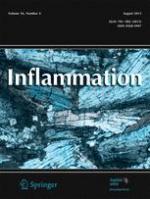Citation:
Ginsburg I, Ward PA, Varani J. Lysophosphatides enhance superoxide responses of stimulated human neutrophils. Inflammation. 1989;13 (2) :163-174.

Abstract:
Human neutrophils which are pretreated with subtoxic concentrations of a variety of lysophosphatides (lysophosphatidylcholine, lysophosphatidylcholine oleoyl, lysophosphatidylcholine myrioyl, lysophosphatidylcholine stearoyl, lysophosphatidylcholine gamma-O-hexadecyl, lysophosphatidylinositol, and lysophosphatidylglycerol) act synergistically with neutrophil agonists phorbol myristate acetate, immune complexes, poly-L-histidine, phytohemagglutinin, and N-formyl-methionyl-leucyl-phenyalanine to cause enhanced generation of superoxide (O2-). None of the lyso compounds by themselves caused generation of O2-. The lyso compounds strongly bound to the neutrophils and could not be washed away. All of the lyso compounds that collaborated with agonists to stimulate O2- generation were hemolytic for human red blood cells. On the other hand, lyso compounds that were nonhemolytic for red blood cells (lysophosphatidylcholine caproate, lysophosphatidylcholine decanoyl, lysophosphatidylethanolamine, lysophosphatidylserine) failed to collaborate with agonists to generate synergistic amounts of O2-. However, in the presence of cytochalasin B, both lysophosphatidylethanolamine and lysophosphatidylserine also markedly enhanced O2- generation induced by immune complexes. O2- generation was also very markedly enhanced when substimulatory amounts of arachidonic acid or eicosapentanoic acid were added to PMNs in the presence of a variety of agonists. On the other hand, neither phospholipase C, streptolysin S (highly hemolytic), phospholipase A2, phosphatidylcholine, nor phosphatidylcholine dipalmitoyl (all nonhemolytic) had the capacity to synergize with any of the agonists tested to generate enhanced amounts of O2-. The data suggest that in addition to long-chain fatty acids, only those lyso compounds that possess fatty acids with more than 10 carbons and that are also highly hemolytic can cause enhanced generation of O2- in stimulated PMNs.Publication Global ID: http://www.ncbi.nlm.nih.gov/pubmed/2547711

